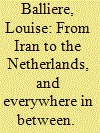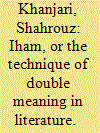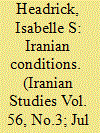|
|
|
Sort Order |
|
|
|
Items / Page
|
|
|
|
|
|
|
| Srl | Item |
| 1 |
ID:
192993


|
|
|
|
|
| Summary/Abstract |
This article is concerned with interregional trade dynamics between Elam and Mesopotamia in the early to mid-first millennium BC. During the seventh century BC, two great famines in the Neo-Elamite kingdom, of which climatological changes were a major cause, were documented in the textual records. An era of megadrought made grain procurement from the neighboring regions essential to feed the Neo-Elamite lowland population. This article further explores the impact of the two Neo-Elamite famines and “drought of the century” on the commercial and political mechanisms in the Upper Persian Gulf region.
|
|
|
|
|
|
|
|
|
|
|
|
|
|
|
|
| 2 |
ID:
192997


|
|
|
|
|
| Summary/Abstract |
A migrant's journey is no linear trajectory from A to B. It is a fragmented and complex move over different regions with alternating periods of mobility and immobility. This article researches the complex dynamics of irregular migration from Iran to the Netherlands, and everywhere in between. Through a historical comparison of the life stories of Iranian asylum seekers in the Netherlands in two time periods (1988–1989 and 2009–2010), it studies the routes they took, their relations with human smugglers, and their interactions with immigration policies and border managements along the way. It shows migrants' and smugglers’ flexibility and capacity to adapt to ever-changing circumstances. Migration politics and border controls, along with their increasing limitations on legal migration channels, are indeed crucial in the understanding of irregular migration practices and the ever-growing involvement of facilitating services. Through a combination of this migration policy research and the migration trajectory research, the paper explores these dynamics and the interactions between migrants, smugglers, and state policies in every phase of their journey from Iran to the Netherlands, and everywhere in between.
|
|
|
|
|
|
|
|
|
|
|
|
|
|
|
|
| 3 |
ID:
192994


|
|
|
|
|
| Summary/Abstract |
This article examines the chapter on īhām (literary amphiboly) in Ḥadāʾiq al-Siḥr by Rashīd Vaṭvāṭ (d. 1182). Ḥadāʾiq, a treatise on stylistics with Persian and Arabic examples, is the oldest extant document to define īhām. Vaṭvāṭ's definition of īhām sheds light on the mechanism and function of this literary technique. This article argues that īhām, according to Vaṭvāṭ, operates through the creation of semantic fields and defamiliarization. Previous scholars who examined this chapter of Ḥadāʾiq, oblivious to this point, have made a number of misinterpretations. However, by analyzing the name he prefers for this figure of speech, the definition he gives, and the examples he cites to explain it, this article demonstrates that Vaṭvāṭ had this function of defamiliarization in mind.
|
|
|
|
|
|
|
|
|
|
|
|
|
|
|
|
| 4 |
ID:
192995


|
|
|
|
|
| Summary/Abstract |
The staff of the Alliance Israélite Universelle (AIU), an international educational philanthropy, were professionally and personally buffeted by health and medical concerns. This article examines the value of their letters, arguing they serve as a deep reservoir of biased yet valuable evidence that corroborates other sources while also providing insight into the health and disease conditions of Iran's provincial cities. This article also asks why, in the early twentieth century, AIU staff failed to acknowledge Iranians who were similarly invested in medical services and public hygiene. Ultimately, the letters help scholars witness historical evolutions in Iran and in the AIU staff's understandings of the Iranian social and medical landscape they inhabited.
|
|
|
|
|
|
|
|
|
|
|
|
|
|
|
|
| 5 |
ID:
192996


|
|
|
|
|
| Summary/Abstract |
This paper examines the Pahlavi Dynasty Museum, which was inaugurated in 1976 during the celebrations marking the fiftieth anniversary of Pahlavi rule. Built inside the Marble Palace, the shah's former residence in the center of Tehran, the museum was intended to memorialize the achievements of the Pahlavis, presenting the official Pahlavi version of Iran's modern history. The museum was unique in many respects, not least because it was the only former Pahlavi palace that had been converted into a museum to honor the Pahlavis, but it shared the objectives of other museums constructed during this period. During the late Pahlavi era, a major aspect of the state's cultural policy was to sponsor initiatives that strengthened the official state narrative, which argued that the Pahlavis were the legitimate heirs of a 2500-year-old monarchical tradition. The article explores how the state attempted to express these narratives through the museum's design and exhibits.
|
|
|
|
|
|
|
|
|
|
|
|
|
|
|
|
|
|
|
|
|